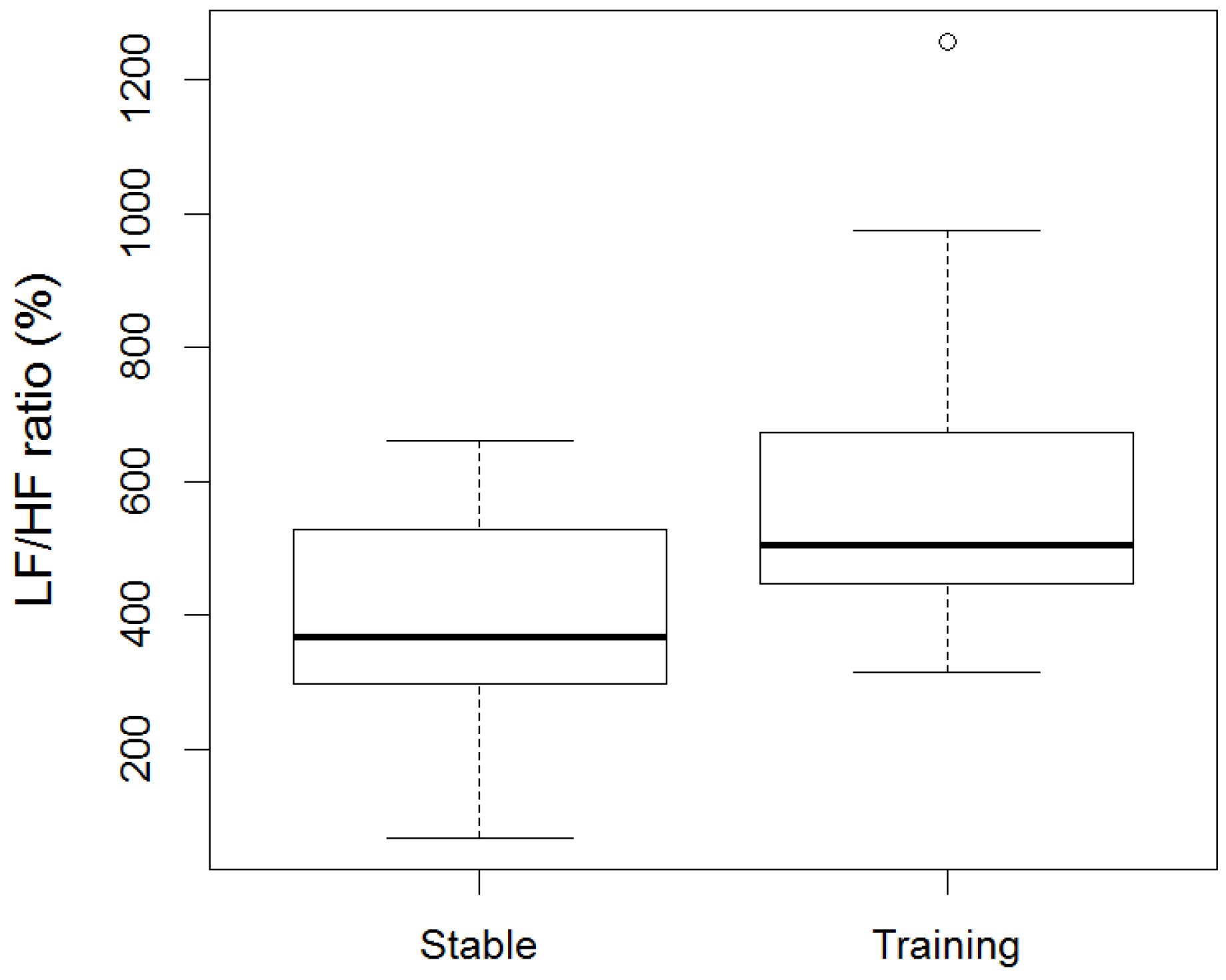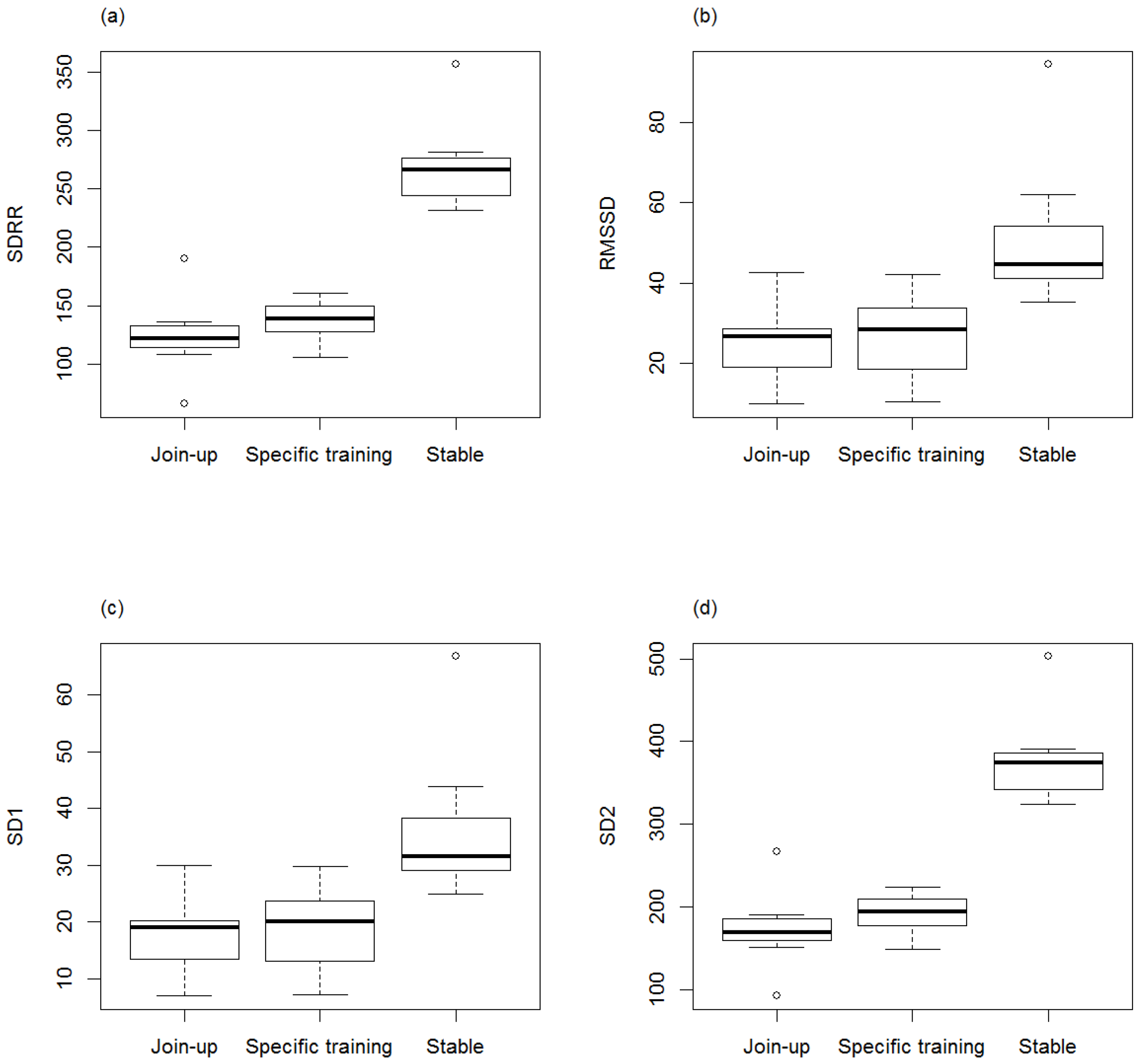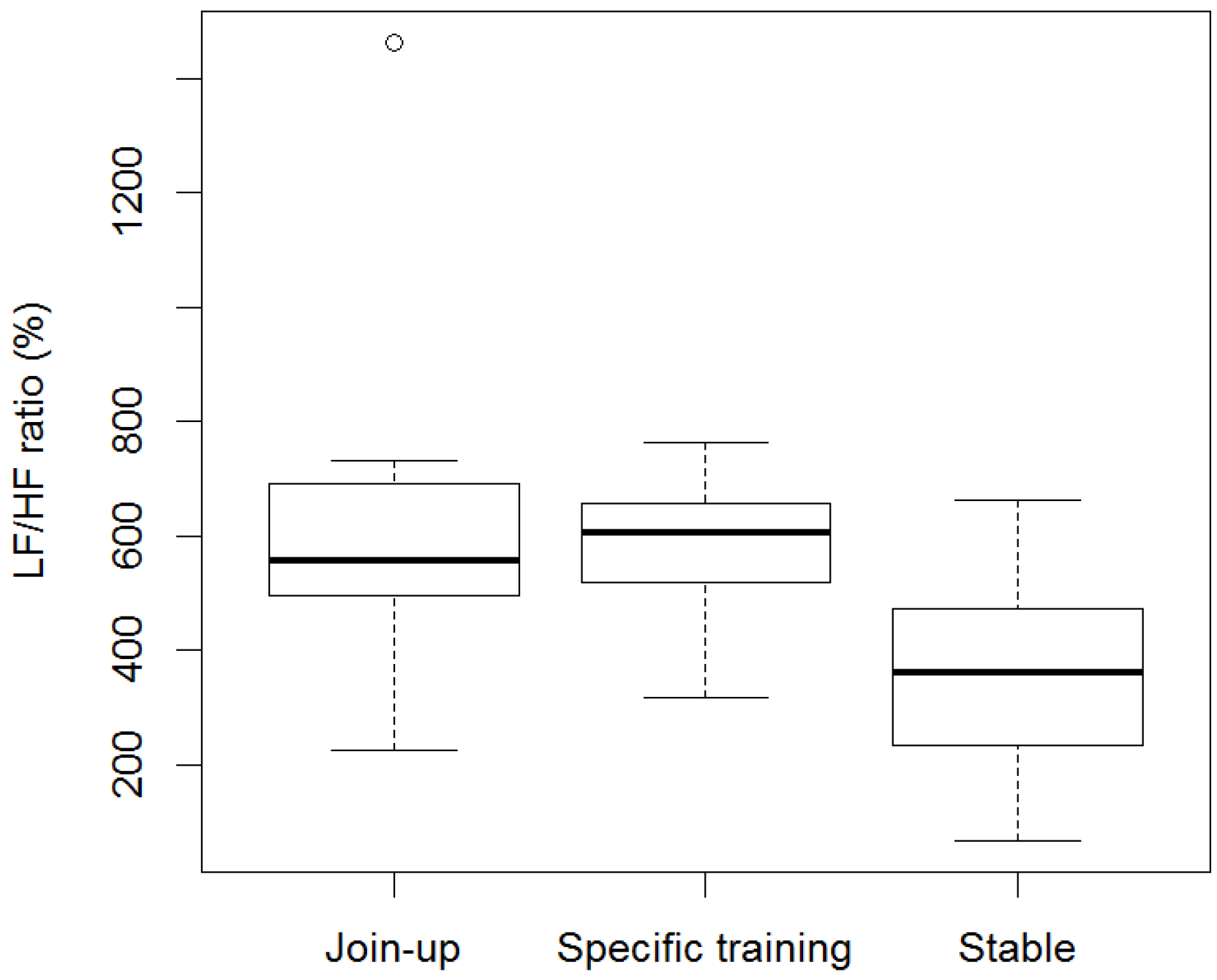Monty Roberts’ Public Demonstrations: Preliminary Report on the Heart Rate and Heart Rate Variability of Horses Undergoing Training during Live Audience Events
Abstract
:Simple Summary
Abstract
1. Introduction
2. Materials and Methods
2.1. Ethical Approval
2.2. Horses and Training Classifications
2.3. Location and Video Recording of Demonstrations
2.4. Trainers, Riders and Owner Involvement
2.5. Training Schedule
2.6. Heart Rate and Heart Rate Variability
2.7. Statistical Analysis
3. Results
3.1. Effect of Overall Training on Heart Rate and Heart Rate Variability during an Audience Demonstration
3.2. Effect of First Join-Up® on Heart Rate and Heart Rate Variability
4. Discussion
5. Conclusions
6. Limitations
6.1. Sex, Age and Breed
6.2. Circadian Rhythm
6.3. Time Since Last Meal
6.4. Physical Exertion
6.5. Pain
6.6. Other Variables Which May Affect HR and HRV Data Interpretation
Acknowledgments
Author Contributions
Conflicts of Interest
References
- Goodwin, D.; McGreevy, P.; Waran, N.; McLean, A. How equitation science can elucidate and refine horsemanship techniques. Vet. J. 2009, 181, 5–11. [Google Scholar] [CrossRef] [PubMed]
- Fowler, V.L.; Kennedy, M.; Marlin, D. A comparison of the Monty Roberts training technique with a conventional UK technique for the initial training of riding horses. Anthrozoos 2012, 225, 302–321. [Google Scholar] [CrossRef]
- Kedzierski, W.; Janczarek, I.; Stachurska, A. Emotional response of naïve Purebred Arabian colts and fillies to sympathetic and traditional training methods. J. Equine Vet. Sci. 2012, 32, 752–756. [Google Scholar] [CrossRef]
- Visser, E.K.; Van Dierendonck, M.; Ellis, A.D.; Rijksen, C.; Van Reenen, C.G. A comparison of sympathetic and conventional training methods on response to initial horse training. Vet. J. 2009, 181, 48–52. [Google Scholar] [CrossRef] [PubMed]
- Physick-Sheard, P.W.; Marlin, D.J.; Thornhill, R.; Schroter, R.C. Frequency domain analysis of heart rate variability in horses at rest and during exercise. Equine Vet. J. 2000, 32, 253–262. [Google Scholar] [CrossRef] [PubMed]
- Von Borell, E.; Langbein, J.; Després, G.; Hansen, S.; Leterrier, C.; Marchant-Forde, J.; Marchant-Forde, R.; Minero, M.; Mohr, E.; Prunier, A.; et al. Heart rate variability as a measure of autonomic regulation of cardiac activity for assessing stress and welfare in farm animals—A review. Physiol. Behav. 2007, 92, 293–316. [Google Scholar] [CrossRef] [PubMed]
- Task Force of the European Society of Cardiology; The North American Society of Pacing and Electrophysiology. Heart rate variability: Standards of measurement, physiological interpretation and clinical use. Comment in Circulation. Eur. Heart J. 1997, 95, 280–281. [Google Scholar]
- Schmidt, A.; Aurich, J.; Möstl, E.; Müller, J.; Aurich, C. Changes in cortisol release and heart rate and heart rate variability during the initial training of 3-year-old sport horses. Horm. Behav. 2010, 58, 628–636. [Google Scholar] [CrossRef] [PubMed]
- Janczarek, I.; Stachurska, A.; Kędzierski, W.; Wilk, I. Responses of horses of various breeds to a sympathetic training method. J. Equine Vet. Sci. 2013, 33, 794–801. [Google Scholar] [CrossRef]
- Munsters, C.C.B.M.; van den Broek, J.; van Weeren, R.; Sloet van Oldruitenborgh-Oosterbaan, M.M. The effects of transport, riot control training and night patrols on the workload and stress of mounted police horses. Appl. Anim. Behav. Sci. 2013, 143, 52–60. [Google Scholar] [CrossRef]
- Munsters, C.; Visser, K.; van den Broek, J.; Sloet van Oldruitenborgh-Oosterbaan, M.M. Quantifying stress in experienced and inexperienced mounted police horses, using heart rate, heart rate variability, behavior score and suitability score. J. Vet. Behav. Clin. Appl. Res. 2013, 8, e16–e17. [Google Scholar] [CrossRef]
- Von Lewinski, M.; Biau, S.; Erber, R.; Ille, N.; Aurich, J.; Faure, J.M.; Möstl, E.; Aurich, C. Cortisol release, heart rate and heart rate variability in the horse and its rider: Different responses to training and performance. Vet. J. 2013, 197, 229–232. [Google Scholar] [CrossRef] [PubMed]
- Kinnunen, S.; Laukkanen, R.; Haldi, J.; Hanninen, O.; Atalay, M. Heart rate variability in trotters during different training periods. Equine Vet. J. Suppl. 2006, 36, 214–217. [Google Scholar] [CrossRef] [PubMed]
- Munsters, C.C.B.M.; Visser, K.E.K.; van den Broek, J.; Sloet van Oldruitenborgh-Oosterbaan, M.M. The influence of challenging objects and horse-rider matching on heart rate, heart rate variability and behavioural score in riding horses. Vet. J. 2012, 192, 75–80. [Google Scholar] [CrossRef] [PubMed]
- Rietmann, T.T.; Stuart, A.E.A.; Bernasconi, P.; Stauffacher, M.; Auer, J.A.; Weishaupt, M.A. Assessment of mental stress in warmblood horses: Heart rate variability in comparison to heart rate and selected behavioural parameters. Appl. Anim. Behav. Sci. 2004, 88, 121–136. [Google Scholar] [CrossRef]
- Villas-Boasa, J.D.; Diasb, D.P.M.; Trigoc, P.I.; dos Santos Almeidaa, N.A.; de Almeidac, F.Q.; de Medeirosa, M.A. Behavioural, endocrine and cardiac autonomic responses to a model of startle in horses. Appl. Anim. Behav. Sci. 2015, in press. [Google Scholar] [CrossRef]
- Visser, E.K.; van Reenen, C.G.; van der Werf, J.T.; Schilder, M.B.; Knaap, J.H.; Barneveld, A.; Blokhuis, H.J. Heart rate and heart rate variability during a novel object test and a handling test in young horses. Physiol. Behav. 2002, 76, 289–296. [Google Scholar] [CrossRef]
- Schmidt, A.; Hödl, S.; Möstl, E.; Aurich, J.; Müller, J.; Aurich, C. Cortisol release, heart rate, and heart rate variability in transport-naive horses during repeated road transport. Domest. Anim. Endocrinol. 2010, 39, 205–213. [Google Scholar] [CrossRef] [PubMed]
- Schmidt, A.; Möstl, E.; Wehnert, C.; Aurich, J.; Müller, J.; Aurich, C. Cortisol release and heart rate variability in horses during road transport. Horm. Behav. 2010, 57, 209–215. [Google Scholar] [CrossRef] [PubMed]
- Erber, R.; Wulf, M.; Aurich, J.; Rose-Meierhöfer, S.; Hoffmann, G.; von Lewinski, M.; Möstl, E.; Aurich, C. Stress response of three-year-old horse mares to changes in husbandry system during initial equestrian training. J. Equine Vet. Sci. 2013, 33, 1088–1094. [Google Scholar] [CrossRef]
- Roberts, M. 1935- From My Hands to Yours: Lessons from a Lifetime of Training Championship Horses; Monty & Pat Roberts Inc.: Solvang, CA, USA, 2002; ISBN 1-929256-56-6. [Google Scholar]
- McGreevy, P.D.; McLean, A.N. Roles of learning theory and ethology in equitation. J. Vet. Behav. 2007, 2, 108–118. [Google Scholar] [CrossRef]
- Wilk, I.; Janczareka, I. Relationship between behaviour and cardiac response to round pen training. J. Vet. Behav. 2015, 10, 231–236. [Google Scholar] [CrossRef]
- Wilk, I.; Kędzierskib, W.; Stachurskaa, A.; Janczareka, I. Are results of Crib Opening Test connected with efficacy of training horses in a round-pen? Appl. Anim. Behav. Sci. 2015, 166, 89–97. [Google Scholar] [CrossRef]
- Becker-Birck, M.; Schmidt, A.; Lasarzik, J.; Aurich, J.; Möstl, E.; Aurich, C. Cortisol release and heart rate variability in sport horses participating in equestrian competitions. J. Vet. Behav. 2013, 2, 87–94. [Google Scholar] [CrossRef]
- Aerts, J.M.; Gebruers, F.; Van Camo, E.; Berckmans, D. Controlling horse heart rate as a basis for training improvement. Comput. Electron. Agric. 2008, 64, 78–84. [Google Scholar] [CrossRef]
- Stucke, D.; Große Ruse, M.; Lebelt, D. Measuring heart rate variability in horses to investigate the autonomic nervous system activity—Pros and cons of different methods. Appl. Anim. Behav. Sci. 2015, 166, 1–10. [Google Scholar] [CrossRef]
- Brennan, M.; Palaniswami, M.; Kamen, P. Do existing measures of Poincaré plot geometry reflect nonlinear features of heart rate variability? IEEE Trans. Biomed. Eng. 2001, 48, 1342–1347. [Google Scholar] [CrossRef] [PubMed]
- Kuwahara, M.; Hiraga, A.; Kai, M.; Tsubone, H.; Sugano, S. Influence of training on autonomic nervous function in horses: Evaluation by power spectral analysis of heart rate variability. Equine Vet. J. Suppl. 1999, 30, 178–180. [Google Scholar] [CrossRef] [PubMed]
- Bowen, I.M. Ambulatory electrocardiography and heart rate variability. In Cardiology of the Horse; Marr, C.M., Ed.; Saunders Elsevier: Edinburgh, UK, 2010; pp. 127–137. [Google Scholar]
- Clément, F.; Barrey, E. Heart rate fluctuations in the horse at rest: (2) Biological variation factors related to behavioural profile. Comptes Rendus Acad. Sci. Ser. III Sci. Vie 1995, 318, 867–872. [Google Scholar]
- Quintana, D.S.; Heathers, J.A. Considerations in the assessment of heart rate variability in biobehavioral research. Front. Psychol. 2014, 22, 805. [Google Scholar] [CrossRef] [PubMed]






| Horse ID | Age (Years) | Demonstration Use | Breed | Sex | Transport Time to Demonstration | Time in Stable Prior to Monitoring | Demonstration Location | In Round Pen before | In Arena before | Audience before |
|---|---|---|---|---|---|---|---|---|---|---|
| A | 3 | Starter | Arab | Gelding | 60 min | 60–180 min | Hadlow | NO | NO | YES |
| B | 3 | Starter | TB × ID | Gelding | 40 min | 60–180 min | Reaseheath | NO | NO | NO |
| C | 3 | Starter | Sports Horse | Mare | 30 min | 60–180 min | Hartpury | NO | NO | NO |
| D | 7 | Remedial-Spooky | Warmblood | Mare | 60 min | 60–180 min | Hadlow | NO | YES | YES |
| E | 11 | Remedial-Spooky | Sports Horse | Gelding | Already on yard one plus week | Reaseheath | NO | YES | NO | |
| F | 2 | Remedial-Loading | Cob × Trotter | Gelding | 60 min | 240–360 min | Hartpury | NO | NO | NO |
| G | 12 | Remedial-Loading | Cob | Mare | Already on yard one plus week | Hadlow | NO | YES | NO | |
| H | 4 | Remedial-Head shy | Appaloosa | Gelding | 60 min | 60–180 min | Hartpury | NO | NO | NO |
| I | 7 | Remedial-Bike phobic | Haflinger | Gelding | 45 min | 60–180 min | Hartpury | YES | YES | YES |
| J | 5 | Remedial-Mounting | TB × ID | Gelding | 90 min | 60–180 min | Reaseheath | YES | YES | YES |
| Horse ID | Training Classification | Recording Time in Stable * | Training Steps | Training Time * |
|---|---|---|---|---|
| A | Starter | 23:13 | 1. 1st Join-Up®, 2. First saddle plus 2nd Join-Up®, 3. First rider (Ardall dummy rider) plus 3rd Join-Up® plus longlines, 4. First real rider (demo rider) | 33:44 |
| B | Starter | 50:44 | 1. Headcollar (Dually™) schooling, 2. 1st Join-Up®, 3. First saddle plus 2nd Join-Up®, 4. First rider (Ardall dummy rider) plus 3rd Join-Up®, 5. First real rider (demo rider) | 34:58 |
| C | Starter | 23:34 | 1. 1st Join-Up®, 2. First saddle plus 2nd Join-Up®, 3. First rider (Ardall dummy rider) plus 3rd Join-Up® plus longlines, 4. First real rider (demo rider) | 46:59 |
| D | Remedial-Spooky | 07:14 | 1. Plastic bag desensitization (plastic bag on end of stick), 2. Tarpaulin desensitization (free movement and leading over tarpaulin) | 31:21 |
| E | Remedial-Spooky | 06:29 | 1. 1st Plastic bag desensitization (plastic bag on end of stick), 2. 1st Join-Up®, 3. 2nd Plastic bag desensitization (plastic bag on end of stick), 4. Tarpaulin desensitization (free movement and leading over tarpaulin) | 29:55 |
| F | Remedial-Loading | 25:14 | 1. Head collar (Dually™) schooling, leading through open panels and over wooden board (ground schooling), 2. Trainer loading, 3. Owner loading | 17:28 |
| G | Remedial-Loading | 06:17 | 1. Head collar (Dually™) schooling, 2. Leading through open panels and over wooden board (ground schooling), 3. Panels closed behind horse; trainer loads horse, 4. Trainer loading horse with open panels, 5. Owner loading horse with no panels | 21:40 |
| H | Remedial-Head shy | 30:25 | 1. 1st Join-Up®, 2. Centaur Training | 23:04 |
| I | Remedial-Bike shy | 18:23 | 1. 1st Join-Up®, 2. Horse tacked up, plastic bag desensitization (plastic bag on end of stick), 3. Ardall dummy legs, 4. Two bikes brought into round pen, horse moved freely forwards to follow bikes (bike desensitization) | 32:06 |
| J | Remedial-Mounting | 12:01 | 1. Head collar (Dually™) schooling, 2. 1st Join-Up®, 3. Tacked up and horse moved forwards and backwards from the ground via head collar, 4. Rider (demo rider) on and horse moved forwards and backwards by mounting block; rider off and horse moved backwards, 5. Horse moved to side of mounting block; Rider (Owner) on | 31:40 |
© 2016 by the authors; licensee MDPI, Basel, Switzerland. This article is an open access article distributed under the terms and conditions of the Creative Commons Attribution (CC-BY) license (http://creativecommons.org/licenses/by/4.0/).
Share and Cite
Loftus, L.; Marks, K.; Jones-McVey, R.; Gonzales, J.L.; Fowler, V.L. Monty Roberts’ Public Demonstrations: Preliminary Report on the Heart Rate and Heart Rate Variability of Horses Undergoing Training during Live Audience Events. Animals 2016, 6, 55. https://doi.org/10.3390/ani6090055
Loftus L, Marks K, Jones-McVey R, Gonzales JL, Fowler VL. Monty Roberts’ Public Demonstrations: Preliminary Report on the Heart Rate and Heart Rate Variability of Horses Undergoing Training during Live Audience Events. Animals. 2016; 6(9):55. https://doi.org/10.3390/ani6090055
Chicago/Turabian StyleLoftus, Loni, Kelly Marks, Rosie Jones-McVey, Jose L. Gonzales, and Veronica L. Fowler. 2016. "Monty Roberts’ Public Demonstrations: Preliminary Report on the Heart Rate and Heart Rate Variability of Horses Undergoing Training during Live Audience Events" Animals 6, no. 9: 55. https://doi.org/10.3390/ani6090055
APA StyleLoftus, L., Marks, K., Jones-McVey, R., Gonzales, J. L., & Fowler, V. L. (2016). Monty Roberts’ Public Demonstrations: Preliminary Report on the Heart Rate and Heart Rate Variability of Horses Undergoing Training during Live Audience Events. Animals, 6(9), 55. https://doi.org/10.3390/ani6090055







